
Why NZ Companies Are Missing Out On Top-Tier Candidates
It’s no secret that New Zealand is experiencing a fairly severe talent shortage. Traditional tactics to attract candidates aren’t enough to get the top talent over the line anymore, and we’re seeing the inter-company competition heating up across the board to secure the candidate they’ve set their sites on.
But what might surprise you, is that it’s not always salaries and work perks that are making the difference between hiring the star performer and letting them slip by.
Our Principal Consultant, Yaman Becerikli, sat down with us to share why he sees companies missing out on top-tier candidates all too often, and a few tips on how to snag (and retain) the best employees.
1. Recognising a good quality candidate
Starting with the basics, if you’re going to attract top talent, you need to know what you’re looking for - what actually makes a good candidate?
A stellar CV and technical skillset are obvious advantages, but in Yaman’s experience, he’s found the best attribute to look for is simply coachability.
“We all know that certain skills can be learnt, but you can’t really teach those fundamental values like coachability and being respectful to others, so it’s essential to look for people who are driven to learn more and always get better.”
In fact, some of the most common attributes observed in high performers are the desire to look for ways to learn and grow personally that will help them help the company grow, and offering respect to everyone they work with, regardless of title or position.
A good candidate is as much about who the person is, as it’s about what they know how to do.
2. Strip away your bias
Regardless of who you are you’ll probably have, even if only a little, some unconscious bias. Straight off the bat, that could mean that you’re overlooking the best candidate in your pile of applications before even calling them to chat.
Accepting this, and putting some steps in place to remedy it, can put you in a much better position to find the right person for the role. Yaman explains;
“What we do in the recruitment spaces is different, we work on those unconscious biases to acknowledge and master them so that there’s no bias at play. There’s also AI available that can come in and get that initial screening part of the process completed in a way that there’s no bias. As we move forward, we’re going to see more automated technology that does this.”
One of the best ways to get rid of your bias once and for all is to ask for the expert help of a recruiter. It’s their sole focus to find the right fit for your company, and they have the technology at their finger tips to help.
3. Control your company reputation, starting with the hiring process
New Zealand is a small place. Two degrees of separation is no joke, and employers are feeling the sting (and benefits, on the flip side) of word of mouth more than ever.
“Companies that are known as having a poor hiring process are starting to have trouble even getting candidates to apply. Your hiring processes are your first impression and should make people feel valued. If you can’t make people feel valued from the get-go, they’re not going to engage, and word gets around” Yaman adds.
That means that even the people you don’t hire might have an impact on future people you want to hire, so it’s important to get your communication into tip-top shape and treat everyone with respect throughout the process.
4. Tailor your hiring process to the role and candidate
There’s a big misconception out there, that a hiring process should be robust, and systematic and require the same approach every time.
From Yaman’s observations, this is the single biggest mistake companies can make and is a surefire way to miss out on great candidates.
“I think the hiring process should always be tailored to the seniority of the individual. You can’t really expect the graduate who’s come straight out of school, to sit with a panel of three senior managers in their space without freaking out and trying to perform under pressure - they’ll crumble in the interview. I think that’s unfair.”
It’s not just in the employee's interest to help them feel comfortable either. If we circle back to point one - getting to know the candidate's values - the only way to really get to know someone and their intentions in an interview setting is to make sure they feel okay to share.
“Back in the day the culture was different, but now, putting people in a place where they feel relaxed and willing to share more information is so important. Always remember, people tense up and panic in interviews and they can’t think clearly about what they can offer. It’s very important that it’s not a one-size-fits-all hiring process.”
Mix up your questions, setting and interview panel. Tailor your job description and listings to the seniority of the role and the type of individual you’re looking for, and you’ll start to see your candidate quality reflect that.
5. Always ask for feedback (and act on it)
This one is a crucial hack that for some reason, gets overlooked. Always - and we mean always - ask for feedback on how your company came across and your hiring process. This is actually something that Yaman looks out for in companies before working with them.
“When it comes to engaging with companies we’re actually pretty picky. You want to make sure that when you put candidates forward they’re going to feel welcomed and supported through the process, so we do our due diligence really well before we represent companies. It affects our reputation as well.”
One of the biggest gripes candidates have is the lack of communication from companies. Recruiters can help to bridge that gap and close the feedback loop so you can actually improve the hiring process without doing the legwork.
“Throughout the process, we hear both sides of the story. What we do is openly and transparently share the lines of communication between the client and the candidate. We say, ‘this is how this person is feeling, and our suggestion is to do this, at this point’, so companies know what to tweak or why they lost out on a top performer.”
Of course, none of this is useful if you don’t make changes based on the feedback received. We can help with that too.
“We follow through - if people say they’re going to do something we make sure it happens - we take notes.”
“Have good intentions, communicate well and ask for feedback”
For Yaman, it really comes down to having a level of EQ and understanding how someone applying for a role would feel throughout the recruitment journey.
“My advice is actually quite simple. Put yourself in their shoes when you’re putting processes and questions in place, and think how you would feel if you were sitting in that seat.”
Winning over the top candidate can be as easy as that.

